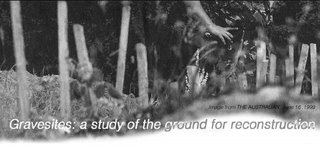Grave sites: a study of the ground for reconstruction
7pm Thursday September 7th, at RMIT Building 50, Orr Street Carlton
Dr. Mirjana Lozanovska,
Gravesites: a study of the ground for reconstruction
In a seminal essay of 1910, Adolf Loos proposed a definition of architecture,
“If we find a mound in the forest, six foot long and three foot wide, formed into a pyramid shape by a shovel, we become serious and something within us says, ‘Someone lies buried here.’ This is architecture.”
Loos’s mound of earth suggests that death and burial are central to the conception of architecture. Ceremonial burial revealed even in excavations of thousand year old sites, through traces of flowers and offerings, exemplifies that the symbolism of death is profoundly integral to humanity. In striking contrast , mass graves found after the war in former Yugoslavia, Bosnia (1992-1995) and Kosovo (1999), were represented as the opposite to these positive dimensions of humanity and specifically as the horror and cruelty of a particular race and culture of people. The gravesite during and after war becomes a contested territory of emotion and representation. It does not yet attain the symbolic place of the monument and tomb. These two sides of human civilization, the former perceived as the epitome of civilization as it ties death with ritual and memory, and the latter as evidence of the cruelty of humans, are tied through death. The latter integrally ties death with war, and its excesses of destruction and violence.
This presentation will focus on Kosovo and the former





No comments:
Post a Comment